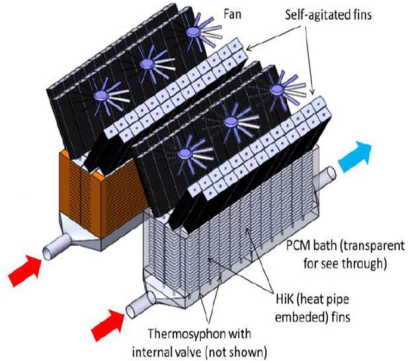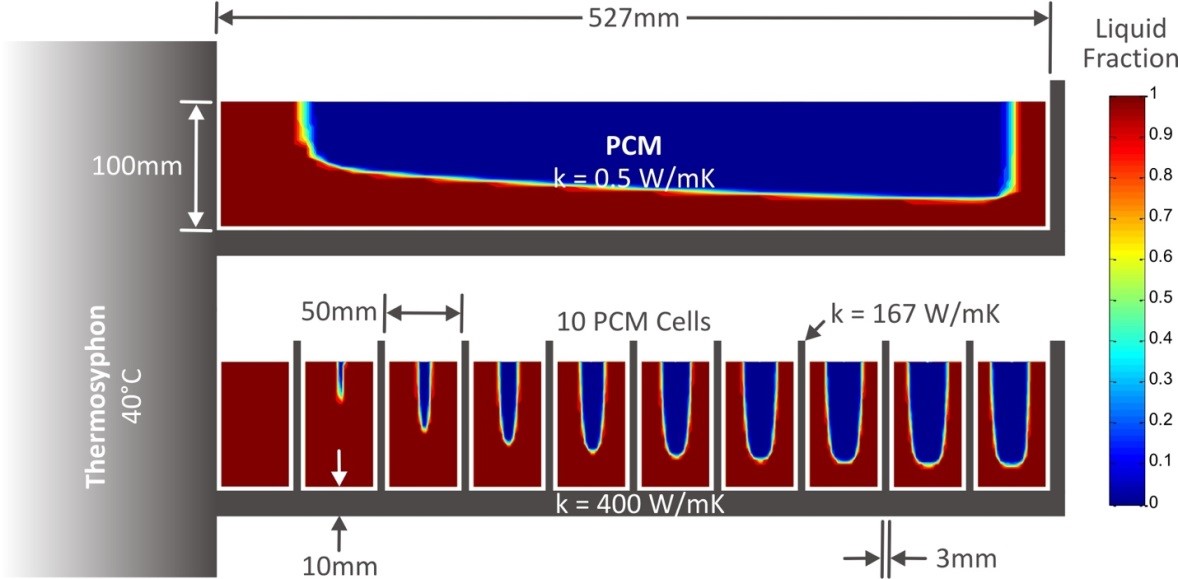Lehigh University
P.C. Rossin College of Engineering and Applied Science
Water-Energy Nexus: Air Cooled Condensers with Thermal Energy Storage
The Energy Research Center is involved on a project for the development of an innovative dry cooling/thermal energy storage system to supplement air cooled condensers (ACCs) for power plant applications. This project, funded by the Advanced Research Projects Agency-Energy (ARPA-E), is a collaborative effort led by Advanced Cooling Technologies, Inc. (ACT, www.1-act.com), with contribution also by the University of Missouri (MU) at Columbia. The three-year project is receiving $3.2 million in total funding from the ARPA-e’s Advanced Research in Dry cooling (ARID) program.
“All power plants must reject heat during power generation to conform to thermodynamic principles. For example, a 100 MWe plant usually has to reject about 200 MWth of heat in the steam condensers,” said Dr. Sudhakar Neti, professor emeritus of mechanical engineering and mechanics, now associated with the Energy Research Center, and co-principal investigator of the project at Lehigh. Neti continues, "once-through steam condensers withdraw significant amounts of water, in the order of 100 L of fresh water per kWh of thermal power generation, which is nowadays considered environmentally unacceptable. Additionally, operation of these condensers has an impact on plant thermal efficiency, and their thermal discharge into the water pool used for cooling is the subject of environmental regulation to protect aquatic life near the power plant discharge. ACCs offer an interesting alternative to the use of once-through condensers; however, they suffer from large thermal inefficiencies impacted by seasonal and daily variable ambient conditions.”
The concept being developed in this project consists of a novel integrated system for better management of power plant condenser heat load. “The concept utilizes an array of heat pipes to transfer heat to a thermal storage unit, thermal energy storage with a phase change material (PCM) to absorb and reject condenser heat when is more efficient from the point of view of the power generating unit, and it incorporates self (flow-induced) agitated fins to increase air-side heat transfer by more than 200%,” says Dr. Richard Bonner from ACT. Members of the team from ACT include Drs. Chien-hua Chen, Ying Zheng, Howard Pearlman, Fangyu Cao and Mr. Sean Hoenig. The figure to the left shows a conceptual diagram of the proposed concept.
Other members of the project team include Dr. Carlos Romero, Director of the Energy Research Center; Joshua Charles, a research scientist and PhD student at the Center; and graduate students, Fengxiang Nie, Chunjian Pan, Arunachalam Subramanian, He Yun and Xingchao Wang. Charles explains, “the type of PCMs being researched in this project provide for latent heat thermal energy storage at higher densities, while providing isothermal energy transfer, which is thermodynamically more efficient. Three PCM materials with melting temperatures around 25°C were selected from more than 50 PCM candidates. PCMs were screened by differential scanning calorimetry (DSC) on melting temperature, latent heat of fusion, thermal conductivity, stability, and cost. The three selected PCMs include combinations of hydrated salts that contain CaCl2, MgCl2 and KNO3.” Current calorimeter testing at Lehigh with these salts target more than 2,500 thermal cycles (more than 200 days of testing) and degradation of PCM storage capacity of less than 10%, with no phase separation and composition changes. Up to date, hydrated salts are meeting the specified target.
Additionally, corrosion experiments and Computational Fluid Mechanics (CFD) modeling are being conducted in the project. Corrosion testing is being carried out under static and dynamic conditions for the selected PCMs and a range of encapsulation materials that include copper; carbon, stainless and Corten steel; and 5086, 6061 and ionized aluminum. Corrosion results up to date have provided guidance on material compatibility for corrosion rate criteria of less than 2 mills/year (0.05mm/year) and less than 12% increase in thermal resistance based on the extent of corrosion. CFD modeling has been used to guide the design and optimization of the thermal energy storage system. Designs have included concentric and axial fins arrangements that provide sufficient heat transfer from the thermosiphon heat source to completely melt and freeze the PCM within appropriate target timeframes for this particular application (see figure below).
According to Chien-hua Chen and Ying Zheng, “the goal of the current project is to demonstrate the concept of an integrated novel condenser with thermal energy storage for power plant-scale applications with a modular 200 kWh laboratory unit. This prototype will be in operation in 2017 for continued performance and reliability testing.” Romero adds, “current cost of electricity estimates for the integrated system are coming below the $150/kWth target specified by ARPA-E for these types of supplemental cooling systems. The ultimate goal is to engineer the concept into a commercial system, and test and optimize a scale-up prototype of the system at a host power plant.”
Related Links:

Diagram of Supplemental Condenser Concept (full version)

Model Results for PCM Module After 10 Hours, With & Without Axial Fins (full version)